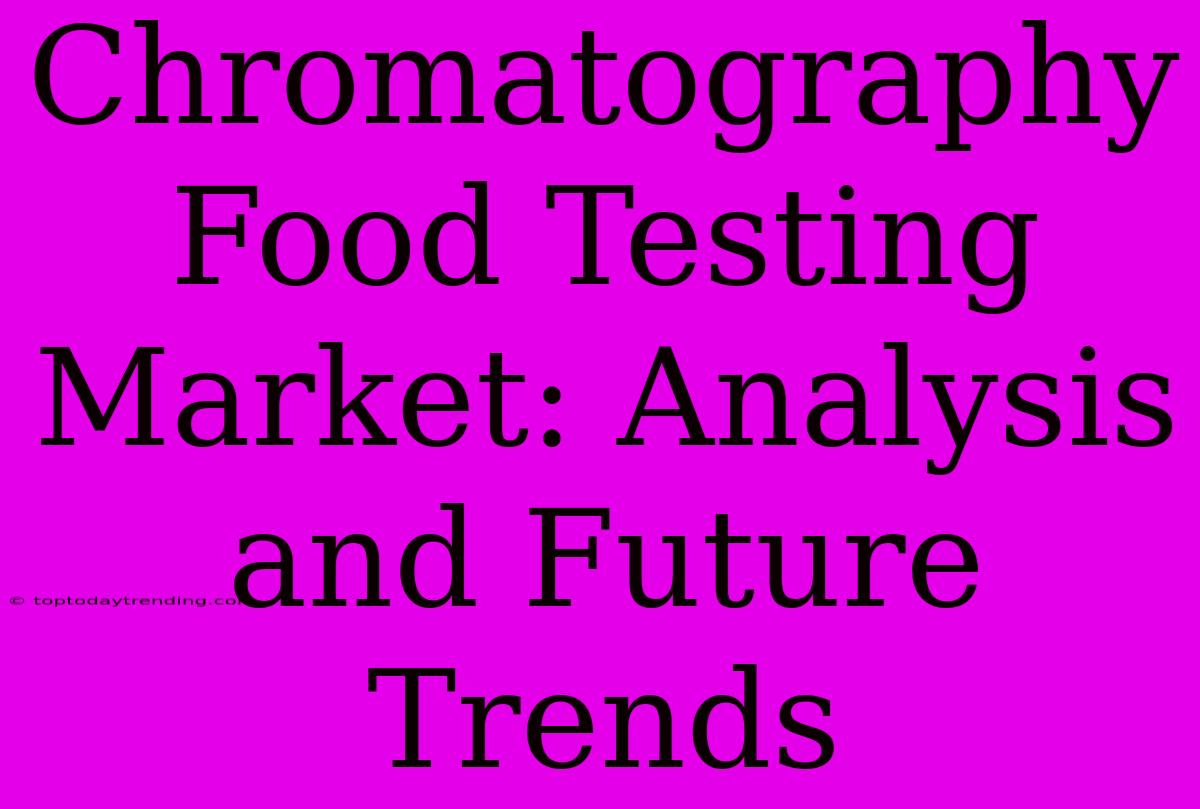Chromatography Food Testing Market: Analysis and Future Trends
The global chromatography food testing market is experiencing a significant surge, driven by increasing consumer awareness of food safety and quality, stringent regulatory standards, and the rising prevalence of food adulteration and contamination. Chromatography techniques, known for their precision and sensitivity in identifying and quantifying various compounds, have become indispensable tools for ensuring food safety and integrity.
This blog post will delve into the intricate landscape of the chromatography food testing market, examining its key drivers, segments, challenges, and future trends.
Market Dynamics:
Key Drivers:
- Growing Consumer Demand for Safe and High-Quality Food: Consumers are increasingly demanding safe and wholesome food products, leading to greater emphasis on food safety testing and quality control.
- Stringent Regulations and Food Safety Standards: Global regulatory bodies are enacting stricter food safety regulations and standards, compelling food manufacturers and processors to adopt robust testing protocols.
- Rising Incidence of Food Adulteration and Contamination: The increasing occurrences of food adulteration and contamination, including the presence of pesticides, heavy metals, and microbial pathogens, necessitate effective analytical techniques like chromatography.
- Technological Advancements in Chromatography: Constant innovations in chromatography technology are introducing faster, more sensitive, and automated systems, enhancing the efficiency and accuracy of food testing.
- Expanding Applications in Food Analysis: Chromatography techniques are finding new applications in food analysis, encompassing allergen detection, nutritional profiling, and traceability.
Market Segmentation:
The global chromatography food testing market can be segmented based on several factors:
- By Technique:
- Gas Chromatography (GC): Widely used for analyzing volatile compounds like pesticides, flavors, and aromas in food.
- High-Performance Liquid Chromatography (HPLC): Suitable for analyzing non-volatile compounds like vitamins, antibiotics, and mycotoxins in food.
- Thin-Layer Chromatography (TLC): A simpler technique for screening and qualitative analysis of various food components.
- By Application:
- Pesticide Residue Analysis: Detecting and quantifying pesticide residues in fruits, vegetables, and other food products.
- Mycotoxin Analysis: Identifying and quantifying mycotoxins, toxic fungal metabolites, in food.
- Antibiotic Residue Analysis: Determining antibiotic residues in meat, poultry, and dairy products.
- Heavy Metal Analysis: Assessing the presence of heavy metals, such as lead, mercury, and cadmium, in food.
- Allergen Detection: Identifying allergenic proteins in food products, ensuring food safety for individuals with allergies.
- Nutritional Profiling: Determining the composition of vitamins, minerals, and other nutrients in food.
- Food Authentication and Traceability: Identifying the origin and authenticity of food products, preventing fraud and ensuring traceability.
- By End-User:
- Food Manufacturers: Ensuring product quality and compliance with safety regulations.
- Government Laboratories: Conducting food safety surveillance and enforcing regulations.
- Research Institutes: Developing new analytical methods and conducting research on food safety and quality.
- Third-Party Testing Laboratories: Providing independent food testing services to manufacturers, importers, and retailers.
Challenges:
- High Initial Investment Cost: Advanced chromatography equipment can be expensive, presenting a significant initial investment for small and medium-sized enterprises.
- Complexity of Chromatography Techniques: Mastering chromatography techniques requires specialized training and expertise, posing a challenge for some food testing laboratories.
- Data Interpretation and Validation: Interpreting chromatography data requires careful analysis and validation to ensure accuracy and reliability.
Future Trends:
- Integration of Chromatography with Other Analytical Techniques: Combining chromatography with other analytical techniques, such as mass spectrometry (MS), will lead to enhanced sensitivity, selectivity, and data analysis capabilities.
- Automation and Miniaturization: Advancements in automation and miniaturization will make chromatography systems more compact, efficient, and user-friendly.
- Increased Use of Chromatography in Food Authenticity and Traceability: Chromatography will play a crucial role in verifying the origin and authenticity of food products, combating fraud and ensuring traceability.
- Development of New Applications: Research and development efforts will lead to the discovery of new applications for chromatography in food analysis, including the detection of emerging contaminants and the identification of novel food ingredients.
Conclusion:
The chromatography food testing market is poised for substantial growth driven by consumer demand, regulatory pressures, and technological advancements. As food safety and quality become increasingly critical, chromatography techniques will remain essential tools for ensuring the integrity of our food supply. By addressing the existing challenges and capitalizing on emerging trends, the market has the potential to shape a safer and more sustainable food future.

